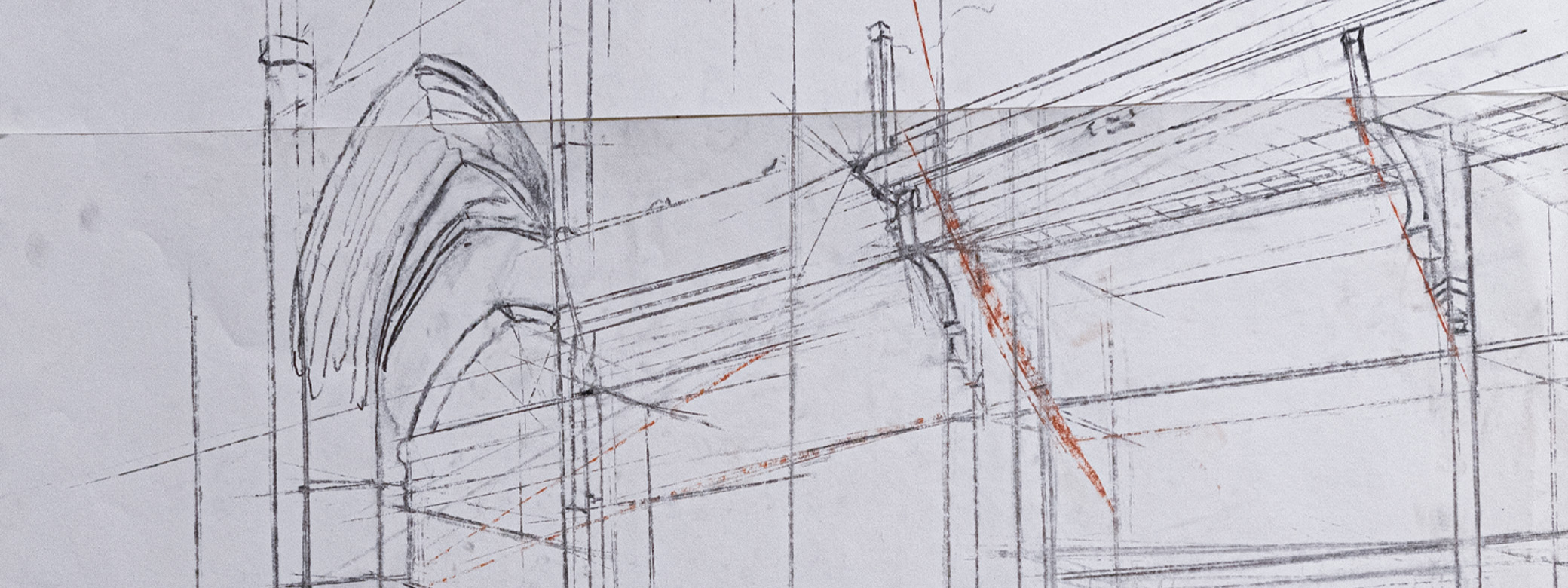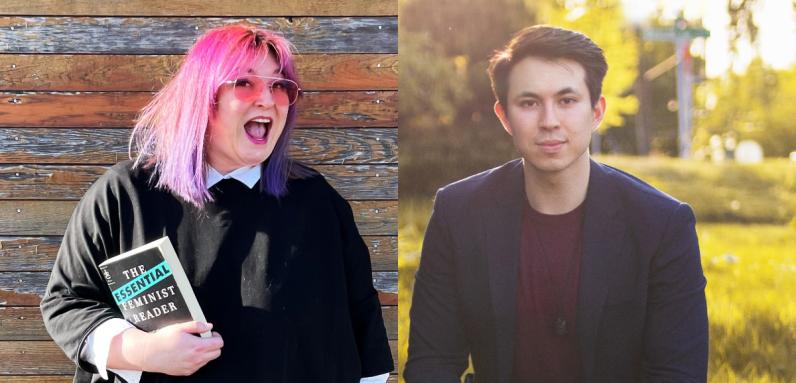Each year, the University of Washington recognizes 100 students from across all three campuses. The Husky 100 website says that these students connect activities inside the classroom and beyond to make a difference at the UW, in communities, and into the future.
Tiffany-Ashton Gatsby, a double-major in Art (Interdisciplinary Visual Art) + Medical Anthropology and Global Health, and Han Eckelberg, a double-major in Art (Photo/Media) + American Ethnic Studies, were both selected for 2021. Eckelberg graduated this month. Gatsby will graduate during the next academic year. Read more about their UW experiences and future plans below.
Tiffany-Ashton Gatsby
As a returning adult student, I spent a longer time than most awaiting to immerse myself into the whole university experience. I was excited to spend long hours studying in the library, finding like-minded peers in student organizations, and waiting for the opportunity to participate in a study abroad program. However, during my second quarter after transferring to the University of Washington from community college, the COVID-19 pandemic shut down the campus and the world. It felt like my experience as a Husky was cut short, but fortunately I was proven wrong. The shutdown inadvertently allowed me greater campus participation and involvement.
As a queer-disabled person, I firmly believe that representation and visibility are essential components of living a successful and fulfilling life, making the recognition as one of the Husky 100 such an important personal achievement. Being one of the Husky 100 brings attention to my community involvements both on and off-campus. I am a board member for the Seattle Dyke March and a volunteer for the National Multiple Sclerosis Society, parliamentarian for Phi Sigma Pi National Honors Fraternity, a member of Qmunity, and a new member of the Mortar Board Senior Honors Society.
Recognition as part of the Husky 100 also brings attention to the research I have engaged in over the past year as part of the Departmental Honors Program in Anthropology: exploring how biomedical interventions often cause trauma for queer-disabled individuals, driving them to seek out community-level healing, achieved through participation in community-based arts projects for public installation. This research was in part made possible due to the several changes associated with remote learning as mobility difficulties are often a challenge to navigating UW’s extensive campus. Switching to synchronous Zoom sessions allowed me to more actively participate in research, interviewing individuals from San Francisco to Toronto, and remotely engaging in collective art sessions with a cohort of my peers.
As a double major in Medical Anthropology and Interdisciplinary Visual Art, I spend my time dedicated to studying. While I was working long studio hours on campus in early 2020 in both introduction to sculpture and my second introductory glass course, which focused on flameworking, the move to Zoom dramatically shifted my artistic practice. I moved to focus more on photographic, collage, and video work which allowed me to create a video from my research project, which was presented at both the UW Undergraduate Research Symposium and the Society for Disability Studies national conference this past year. None of this would have been possible if I were still working in the art studios on campus. The accessibility of remote interactions allowed me to establish a rapport with fellow students and professors and removed some of the initial biases I sometimes faced regarding my age or disabilities. I was even able to attend more courses without worrying about the physical exhaustion from traversing campus interfering with my stamina.
In the upcoming year, I hope to take what I’ve learned remotely and convert the knowledge to practices appropriate for in-person studio work as part of the School of Art + Art History + Design’s Departmental Honors Program. I am looking forward to continuing my research on queer-disabled bodies, examining the performativity of both queer and disabled embodiment and how that shapes our interactions with the world, and the UW campus in particular. I also hope to participate in a study abroad program, as both programs I planned to attend were canceled due to COVID-19. This autumn, I will be applying for graduate programs in Medical Anthropology. I hope to stay here at UW and continue exploring healing through art in the queer-disabled community.
Han Eckelberg
As part of the Husky 100, I feel honored that my hard work within UW has been recognized, bringing me a sense of validation and gratitude. I am the son of a Hong Kong immigrant and a third-generation German American. I grew up in Beacon Hill, Seattle’s Asian Pacific Islander American (APIA) enclave, surrounded by many people I called “aunts,” “uncles,” and “cousins.” For three decades, my zip code was among the most diverse in the United States. My neighborhood’s cultural diversity fostered my passion for the arts, advocacy for the community, and pride in my heritage. Receiving the Husky 100 makes me feel like I have represented my community well, bringing me strength and even more conviction to continually represent my home.
In my ART 340 class, I had the opportunity to exhibit artwork in Odegaard Library that expressed three themes of my UW art career: movement, landmarks, and ethnic history. Applying my American Ethnic Studies academic knowledge of culture, Asian American media representation, and Black Indigenous People of Color (BIPOC) philosophy, I challenged myself to create a 110" x 110" golden "Bruce Lee Ascending (飛小龍)" mural on the library’s central staircase. I wanted to acknowledge that Bruce Lee, idolized by many, studied drama and philosophy at UW in the early 1960s. Stunned that UW’s campus has nothing to honor him, I wanted to fill that void. By combining a Bruce Lee quote about martial arts with UW’s slogan ("When one has reached maturity in the art, one will have a boundless form"), this piece reminds all students that gaining knowledge in any art requires hard work and discipline. In keeping with his philosophy, to see the mural’s message and gain deeper knowledge, the viewer must get close, step up, and exert effort to ascend.
In addition, Bruce Lee’s Chinese name is “Li Xiaolong” or “the little dragon.” In East Asia, there is the legendary story about a carp that could swam upstream and lept the falls of the Yellow River at the Dragon Gate (Longmen) to be transformed into a dragon. This has become the symbol in many parts of East Asia about academic success. In this sense, Bruce Lee, the little dragon, is swimming upstream, and we will follow him to achieve academic success.
This project posed numerous technical difficulties, and my failure or success, given the work’s size and central location in the library, would be on full display. I spent many nights at Odegaard planning, then installing, this project. I could have settled for something much smaller in scale, and at times I doubted my skills and the feasibility of this mural. But in that Photo/Media class, our discussions about being mindful of our exhibition space, the viewer’s perspective, and the action required to view our artwork, inspired me to work diligently and persevere. During installation and after completion, I received affirmation from classmates, staff, professors, community members, and countless other individuals who shared, posted, and discussed my artwork. It took me two days to install the mural, and the people who watched me, came to see and appreciate the mental and physical work that goes into creating art.
My goal is to continue pursuing and passing on my life’s passions: American Ethnic Studies, BIPOC history, exhibition work, and video directing. I want to amplify APIA voices and visions in art and share the tools needed to express those voices. I want to be an artist who teaches about APIAs in art, film, and media, drawing on my background and learning to produce/design artwork incorporating API and APIA elements. Ultimately, I want to be the "cousin" who inspires, teaches, and works with others to create relevant APIA art and designs. To this end, I will be attending the Communication Leadership graduate program at UW, hoping to make an everlasting artistic contribution to my community and to the world.

